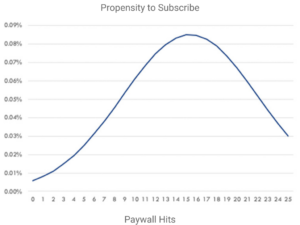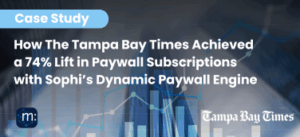August 20th, 2024
By Arvid Tchivzhel, SVP of Technology
In an industry where content is king, understanding reader behavior is essential for publishers aiming to succeed in today’s digital age. Pioneers like Mediahuis have demonstrated that personalizing the user journey based on an individual’s likelihood or propensity to subscribe, can significantly boost subscriptions while safeguarding advertising revenue. Propensity modeling, therefore, emerges as a valuable tool for publishers, enabling them to craft strategies that not only drive conversions but also deepen their understanding of their readers.
To effectively leverage propensity modeling insights, publishers must first understand the concept of marginal effects, which reveal how incremental changes in specific variables impact a reader’s likelihood or propensity to subscribe.
Mather Economics has developed subscription propensity models for several publishers, helping them activate these insights through their tech stack to drive revenue. In doing so we have observed how the following variables influence subscriber propensity:
- User Engagement (e.g., pageviews, visits, time on site, etc.)
- Environment (e.g., device, location, day of the week, time of day, etc.).
- Product (e.g., content categories, user experience, site speed, etc.).
- Marketing Calls-to-Action (e.g., paywall modal, newsletter offer, price/discount, nurturing pop-up, etc.)
Our research shows that readers with a greater breadth of content consumption (i.e., engaging with different topics) tend to have a higher likelihood of subscribing. Although higher monthly visits, scroll depth, and time per visit also improve subscription rates, their impact is relatively lower.
Mather has also explored the relationship between paywall hits and propensity to subscribe. Interestingly, a reader’s propensity to subscribe increases with each paywall hit, but only up to a certain point (See Image 1 below). Beyond this threshold, additional paywall hits tend to decrease subscription likelihood. It should be noted that this point of diminishing returns varies across markets based on the paywall strategy, pricing models, and the quality of digital products.
Image 1: Propensity to Subscribe based on Paywall Hits over a 30-day period

Turning Insights into Impact
While publishers can’t control variables like location or device, and product changes require long-term investment, they can more easily and quickly influence reader behavior through content and marketing strategies to boost engagement and subscription propensity.
For example, knowing that reading more diverse content increases subscription propensity, publishers can encourage readers to explore more varied content through personalized recirculation strategies and calls to action, such as engaging with newsletters, podcasts, and other content formats.
Building on the insight that subscription propensity declines after repeated paywall exposures (Image 1 above), publishers can refine their strategy by using propensity insights to target subscription offers more effectively. Specifically, for users who have been repeatedly exposed to paywall modals—termed ‘high modal non-subscribers‘ by Mather—consider offering alternatives such as guest passes for registration or access to content in exchange for completing a reader survey. This approach aims to address the friction or concerns preventing them from subscribing and enhance their overall experience.
Removing the Guesswork: How AI Enhances Decision-Making
To boost subscription rates and future–proof their business models, publishers should consider leveraging AI to gain deeper insights into reader behavior and optimize paywall decisions. AI-powered solutions analyze large amounts of user and content data in real time, providing a sophisticated alternative to traditional paywalls and manual guesswork. A prime example of this is Sophi’s Dynamic Paywall Engine, which optimizes paywall decisions to maximize revenue, align with audience preferences, and fully unlock the power of content. At the core of this tool is advanced propensity modeling, empowering publishers with cutting-edge data science while freeing up team resources to concentrate on their core mission
Closing thoughts
Propensity-based decision-making has become the new standard, and understanding marginal effects is crucial for publishers to refine their strategies, optimize user experience, and drive higher conversions. However, propensity modeling is inherently complex, and adapting to evolving trends can be both time-consuming and resource intensive. This is where partnering with a strategic partner and leveraging best-in-class AI solutions can be very valuable.
Ready to leverage AI and expert insights to elevate your subscription strategies?
Contact our team today to learn how we can help you quickly act on user and content data to drive revenue!
Read more insights





